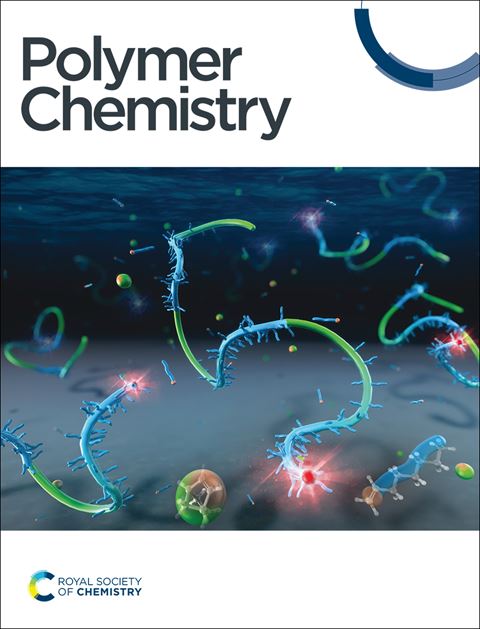碳点驱动近红外光诱导微乳液原子转移自由基聚合
IF 3.9
2区 化学
Q2 POLYMER SCIENCE
引用次数: 0
摘要
光致聚合方法因其操作条件温和、时空控制精确和操作简单而越来越受到重视。除了均相体系,适应光聚合乳液提供了一个更环保和更实用的方法。然而,以往研究中普遍采用的短波光源穿透力差,加之异质系统固有的不透明性,导致光能利用效率低下。本文利用磷氮共掺杂碳点(PN-CDs)作为光催化剂,制备了一种高效的近红外(NIR)光诱导微乳液原子转移自由基聚合(迷你atrp)。由于PN-CDs在近红外区的吸收,在808 nm激光的激发下,PN-CDs可以产生电子,从而在油/水滴界面与Cu(II)/表面活性剂离子对进行电子转移,引发mini-ATRP。该近红外诱导的迷你atrp系统在2小时内成功制备出低分散性(Đ<1.25)和高单体转化率(~86%)的聚合物。分别通过光开关实验和链延伸实验证明了聚合物的聚合和链保真度具有良好的时间控制性。本研究为强大的乳液光聚合技术建立了新的途径,提供了更好的控制,效率和更可持续的过程。本文章由计算机程序翻译,如有差异,请以英文原文为准。
Carbon dots driven near infrared light induced miniemulsion atom transfer radical polymerization
Photoinduced polymerization methods are increasingly valued for their mild operating conditions, precise spatiotemporal control, and operational simplicity. Beyond homogeneous systems, adapting photopolymerization to emulsions offers a greener and more practical approach. Nevertheless, the poor penetration of short-wavelength light sources commonly adopted in prior studies, combined with the opacity inherent to heterogeneous systems, led to inefficient light energy utilization. This work presents an efficient near-infrared (NIR) light induced miniemulsion atom transfer radical polymerization (mini-ATRP), by utilizing phosphorus and nitrogen codoped carbon dots (PN-CDs) as the photocatalyst. Owing to the absorption in the NIR region, PN-CDs can generate electrons under excitation by an 808 nm laser, thereby initiating mini-ATRP through electron transfer with Cu(II)/surfactant ion-pair at the interface of oil/water droplets. This NIR induced mini-ATRP system successfully produced polymers with low dispersity (Đ<1.25) and high monomer conversion (~86%) within 2 hour. Excellent temporal control of the polymerization and the chain fidelity of polymers were illustrated by light-switching experiment and chain extension, separately. This research establishes new pathways for robust emulsion photopolymerization techniques, providing enhanced control, efficiency, and a more sustainable process.
求助全文
通过发布文献求助,成功后即可免费获取论文全文。
去求助
来源期刊

Polymer Chemistry
POLYMER SCIENCE-
CiteScore
8.60
自引率
8.70%
发文量
535
审稿时长
1.7 months
期刊介绍:
Polymer Chemistry welcomes submissions in all areas of polymer science that have a strong focus on macromolecular chemistry. Manuscripts may cover a broad range of fields, yet no direct application focus is required.
 求助内容:
求助内容: 应助结果提醒方式:
应助结果提醒方式:


